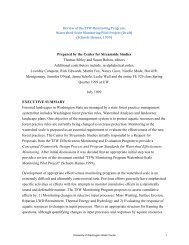Copyright 2012 Aileen M. Echiverri-Cohen - University of Washington
Copyright 2012 Aileen M. Echiverri-Cohen - University of Washington
Copyright 2012 Aileen M. Echiverri-Cohen - University of Washington
You also want an ePaper? Increase the reach of your titles
YUMPU automatically turns print PDFs into web optimized ePapers that Google loves.
lower rates <strong>of</strong> correct identification <strong>of</strong> the second target under Lag 2 and 3 conditions (e.g., one<br />
or two distractors presented between targets). With more than two intervening distractors,<br />
participants are again able to correctly identify both targets under Lag 4 and 5 conditions. This is<br />
termed an "attentional blink," referring to a deficit in the ability to identify a second target <strong>of</strong> a<br />
pair <strong>of</strong> stimuli presented closely in time. This is thought to happen because the presentation <strong>of</strong><br />
two or more distractors allows the participant to recover from the impairment in attention.<br />
Accordingly, when plotting accuracy <strong>of</strong> identification <strong>of</strong> the second target (T2), a U-shaped<br />
pattern emerges as a function <strong>of</strong> length <strong>of</strong> lag.<br />
Cognitive models <strong>of</strong> AB that explain this U-shaped pattern fall into two categories: early<br />
(attentional gating model; Weighselgartner & Sperling, 1987; inhibition model, Raymond, et al.,<br />
1992) or late selection (two-stage processing model; Chun & Potter, 1995, interference model;<br />
Shapiro, Raymond, & Arnell, 1994). Both highlight the limitations in processing two targets<br />
close in time within a stream <strong>of</strong> stimuli (Peterson & Juola, 2000). Early selection refers to the<br />
recruitment <strong>of</strong> attentional resources in the early stage <strong>of</strong> visual processing initiated by the<br />
processing resources needed in the identification <strong>of</strong> the first target that leads to poor<br />
identification <strong>of</strong> the second target. In contrast, with late selection, attentional resources are<br />
recruited by an item in the distractor position immediately following the first target leading to<br />
limited resources in processing the second target. Although more studies are consistent with late<br />
selection (e.g., Vogel, Luck, & Shapiro, 1998, Vogel & Luck, 2002; Di Lillo et al., 2005) than<br />
early selection theories (e.g., Giesbrecht & Kingstone, 2004), others show that attentional<br />
mechanisms may operate at multiple levels <strong>of</strong> perception. Indeed, recent studies have adopted a<br />
connectionist model that suggests that both perceptual and post-perceptual level selection in AB<br />
can occur (Bowman & Wyble, 2007; Giesbrecht et al., 2009), depending on task demands (e.g.,<br />
8
















